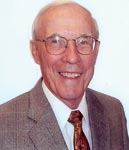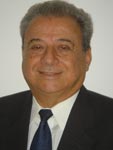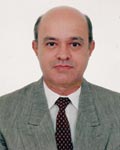Washington, DC
October 19, 2006
The recipients of the 2006 World
Food Prize were announced June 15 at a ceremony at the U.S.
State Department featuring Nobel Peace Prize Laureate Dr. Norman
E. Borlaug and hosted by the Hon. Josette Sheeran Shiner, Under
Secretary of State for Economic, Business, and Agricultural
Affairs.
World Food Prize Foundation President Ambassador Kenneth M.
Quinn announced that the three men who will share the 2006 World
Food Prize are:
The $250,000 World Food Prize was
established in 1986 by Dr. Borlaug. Celebrating its 20th
anniversary this year, it was created to be the foremost
international award for achievements that significantly increase
the quality, quantity or availability of food in the world.
Ambassador Quinn noted that this year marks the first time in
its twenty-year history that the World Food Prize will be
awarded to three recipients. Lobato and Paolinelli are the first
World Food Prize Laureates from Brazil, while McClung is the
eleventh Laureate from the United States. Quinn added that the
2006 recipients each played a vital role in transforming the
Cerrado – a region of vast, once infertile tropical high plains
stretching across Brazil – into highly productive cropland.
Though they worked independently of one another, in different
decades and in different fields, their collective efforts over
the past 50 years have unlocked Brazil’s tremendous potential
for food production. Their advancements in soil science and
policy leadership made agricultural development possible in the
Cerrado, a region named from Portuguese words meaning “closed,
inaccessible land.”
“This increased agricultural production has helped improve
economic and social conditions in Brazil, while their research
continues to promote agricultural development and poverty
alleviation in other tropical and sub-tropical countries
throughout the world,” said Quinn. Quinn noted that from 1970 to
2000 Brazil’s agricultural production more than tripled while
its area of cultivated land grew less than 1.5 times.
Dr. Borlaug, who is credited with saving more than one billion
lives as the Father of the Green Revolution, called the
development of the Cerrado “one of the great achievements of
agricultural science in the 20th century, which has transformed
a wasteland into one of the most productive agricultural areas
in the world.”
The World Food Prize will be formally presented at a ceremony on
October 19, 2006 at the Iowa State Capitol Building in Des
Moines. The ceremony will be held as part of the World Food
Prize International Symposium, entitled “The Green Revolution
Redux: Can We Replicate the Single Greatest Period of Food
Production in All Human History?” Follow the links for more
information about the Symposium and Laureate Award Ceremony.
 Laureates’
Achievement Laureates’
Achievement
Dr. A. Colin McClung’s pioneering soil fertility research in
the 1950s analyzed the complexity of Cerrado soils and showed
that a transformation of the region was possible. His work
uncovered an innovative soil improvement process to correct the
drastic nutrient depletion of the Cerrado and counteract
aluminum toxicity in the region’s highly acidic soils. Dr.
McClung concluded that, with a combination of lime,
micronutrients and traditional fertilizer, the Cerrado could be
made suitable for production of crops as diverse as coffee,
soybeans, citrus and corn.
 His
findings paved the way for agricultural development in the
Cerrado in the 1970s under the direction of
H.E. Alysson Paolinelli. Beginning his career as Secretary
of Agriculture in the state of Minas Gerais in the early 1970s,
Paolinelli created a new model for rural credit and other
development programs. He envisioned and oversaw the creation of
the institutional and financial infrastructure that enabled crop
and livestock production to flourish in the Cerrado. His focus
on the Cerrado continued as Minister of Agriculture from 1974 to
1979, when he was instrumental in establishing the Brazilian
Agricultural Research Corporation (EMBRAPA) to provide a
national system of research, technical, and administrative
support to farmers and agribusinesses. Paolinelli also provided
leadership in establishing the Cerrado Research Center as part
of EMBRAPA in 1975. This center’s work, in concert with that of
other organizations and businesses, set the stage for the
Cerrado’s continued development into an agricultural powerhouse
of the 21st century. His
findings paved the way for agricultural development in the
Cerrado in the 1970s under the direction of
H.E. Alysson Paolinelli. Beginning his career as Secretary
of Agriculture in the state of Minas Gerais in the early 1970s,
Paolinelli created a new model for rural credit and other
development programs. He envisioned and oversaw the creation of
the institutional and financial infrastructure that enabled crop
and livestock production to flourish in the Cerrado. His focus
on the Cerrado continued as Minister of Agriculture from 1974 to
1979, when he was instrumental in establishing the Brazilian
Agricultural Research Corporation (EMBRAPA) to provide a
national system of research, technical, and administrative
support to farmers and agribusinesses. Paolinelli also provided
leadership in establishing the Cerrado Research Center as part
of EMBRAPA in 1975. This center’s work, in concert with that of
other organizations and businesses, set the stage for the
Cerrado’s continued development into an agricultural powerhouse
of the 21st century.
 Mr.
Edson Lobato was a leader in evaluating and carrying out
studies of Cerrado soil fertility and agricultural production,
further expanding upon the work of McClung and Paolinelli.
During the course of his 30-year career as an agronomy engineer
and administrator at EMBRAPA (1974 to 2004), Lobato led Cerrado
soil fertility and agronomy research as it expanded to include
soil microbiology, soil management, and crop management. The
success of Lobato’s diligence and leadership, coupled with the
efforts of his colleagues, allowed for an expansion of
agricultural development on the Cerrado. Mr.
Edson Lobato was a leader in evaluating and carrying out
studies of Cerrado soil fertility and agricultural production,
further expanding upon the work of McClung and Paolinelli.
During the course of his 30-year career as an agronomy engineer
and administrator at EMBRAPA (1974 to 2004), Lobato led Cerrado
soil fertility and agronomy research as it expanded to include
soil microbiology, soil management, and crop management. The
success of Lobato’s diligence and leadership, coupled with the
efforts of his colleagues, allowed for an expansion of
agricultural development on the Cerrado.
BACKGROUND ON Brazil’s Cerrado
Region
From only 200,000 hectares of
arable land in 1955, the Cerrado had well over 40 million
hectares in cultivation by the year 2005. The phenomenal
achievement of transforming the infertile Cerrado region into
highly productive land over a span of fifty years, the world’s
single largest increase in farmland since the settlement of the
U.S. Midwest, has been hailed as a far-reaching milestone in
agricultural science.
The Cerrado is an arid brush savanna stretching over 120 million
hectares across central Brazil from the western plains to the
northeastern coast. With soils characterized by high acidity and
aluminum levels that are toxic to most crops, Brazilian farmers
had long referred to the area as campos cerrados – “closed
land,” with little promise for sustaining production.
 The
Cerrado’s potential was first unlocked by applications of lime
and phosphate-rich fertilizers, which together reduced acidity
and improved fertility in the soil. Initial tests by Colin
McClung in the 1950s dramatically increased yields of a variety
of crops within one growing season. Later agronomy research and
extension work with farmers was led by Edson Lobato. His efforts
and those of his colleagues further refined fertilizer and soil
nutrient applications in the Cerrado. The
Cerrado’s potential was first unlocked by applications of lime
and phosphate-rich fertilizers, which together reduced acidity
and improved fertility in the soil. Initial tests by Colin
McClung in the 1950s dramatically increased yields of a variety
of crops within one growing season. Later agronomy research and
extension work with farmers was led by Edson Lobato. His efforts
and those of his colleagues further refined fertilizer and soil
nutrient applications in the Cerrado.
The promise of improved soils spurred nationwide reforms of
agricultural research and extension programs on the federal and
state levels. Organized under Minister of Agriculture Alysson
Paolinelli, Brazil’s federal agricultural research organization
EMBRAPA has emerged as a global leader for improving degraded
tropical soils and breeding enhanced crops. EMBRAPA is the
source of 30 percent of all public research in Latin America,
and it maintains strong partnerships with research institutions
and universities internationally.
With improved soil chemistry and the support of flexible
research institutions, plant scientists in Brazil have developed
high-yielding crop varieties for the Cerrado that are more
tolerant of aluminum toxicity and acquire soil micronutrients
more effectively. In recent years, agronomists have also refined
no-till or direct planting technologies, reducing environmental
degradation and maintaining higher levels of soil organic
matter.
The Cerrado region now provides 54 percent of all soybeans
harvested in Brazil, 28 percent of the country’s corn, and 59
percent of its coffee. Cerrado agriculture has also diversified
to include rice, cotton, cassava, and sugar. For all crops,
average yields in the Cerrado are higher than in other areas,
with harvests reaching 4.8 tons per hectare of soybeans and 11
tons per hectare of corn. In addition, the Cerrado supports 55
percent of Brazil’s beef industry.
The increased production of a variety of crops and livestock has
made food more available and more affordable in Brazil. In the
past 25 years, food prices have steadily dropped by an average
of 5 percent annually. At the same time, the standard of living
for many rural communities has been enhanced, with life-quality
indicators rising 47 percent from 1970 through the 1990s.
“Eventually, the Cerrado technology, or one similar to it, will
move into the llanos in Colombia and Venezuela and hopefully,
into central and southern Africa where similar soil problems are
found,” said Nobel Peace Prize Laureate and World Food Prize
Founder Dr. Norman E. Borlaug. “This will bring tens of millions
of additional acres, previously marginal for agriculture, into
high-yield agriculture. Hundreds of millions of people will
benefit from this work.”
RELATED RELEASE:
Pesquisador da Embrapa recebe prêmio World
Food Prize |